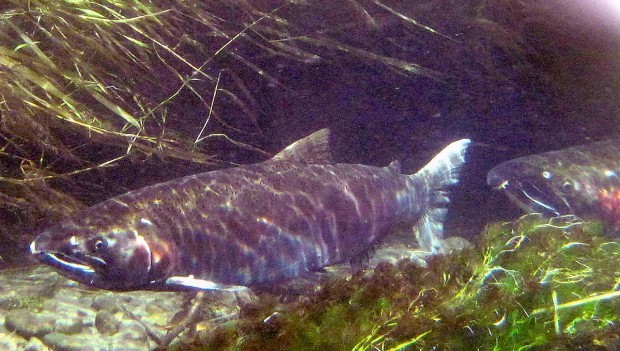home | internet service | web design | business directory | bulletin board | advertise | events calendar | contact | weather | cams

|
First Coho Season in Decades  Coho salmon in the Methow River. As many as 10,000 may return to spawn this year, enough to allow a coho fishing season. (photo: Bonneville Power Administration) Coho salmon in the Methow River. As many as 10,000 may return to spawn this year, enough to allow a coho fishing season. (photo: Bonneville Power Administration)Coho released from the national fish hatchery in Winthrop by the Yakama Nation are returning to the Methow River in such large numbers that a coho fishing season opened Oct. 5 for the first time in more than 30 years. As many as 10,000 coho may find their way up the Methow River on the way home to spawn, according to Bob Jateff, the state’s Okanogan District fish biologist. Rick Alford, fish biologist for the Yakama, predicted somewhat fewer, perhaps 7,000 to 8,000 fish. Typically only 1,500 coho have shown up at Wells Dam, though the return has been as high as 4,000. At any rate, said Alford, “It’s going a bit beyond expectations. We’re tickled with it.” The four to eight-pound coho moving upriver now are three years old. The tribe is teaching these coho to be upper Methow fish, which means they have to stay in the nursery longer than other salmon species to acclimate to the water in their new home. For the tribe’s brood stock development process to succeed, the fish need to adapt and imprint on spawning areas in the upper-Columbia tributaries, not those in the lower Columbia, where the breed stock originated, he explained. So they’re not sent downriver until they’re 15 months old. Last year some 500,000 coho went downstream from Winthrop. The tribe collects some of the returning fish at Wells Dam for the breeding program. The ones that make it to Winthrop swim back into a weir at the hatchery and trap themselves so their eggs can easily be collected, said Alford. The tribe’s coho restoration effort in the Methow began in 1996 and is funded in part by the Bonneville Power Administration and public utility districts that own dams that have impeded fish passage up the Columbia and destroyed the fishery. Coho originally were the most numerous fish in the upper Columbia Basin, including the Methow River, said Alford. The Methow coho fishery is co-managed with the state, though the tribe claims authority under historic treaty agreements to set its own season rules. The tribal fishery on this run is concentrated in the Columbia, where the fish are more accessible, according to Alford. That so many coho have returned to the Methow River that they can be fished for the first time in decades is a dramatic demonstration that salmon can be made to adapt and imprint a memory of new origins. Alford said few other similar, successful adaptation experiments exist. The Washington Department of Fish and Wildlife has made some attempts to restore the runs to little avail. The next phase of the tribe’s coho restoration effort in the Methow will be to entice the fish further upstream so they don’t all stop in Winthrop. That means the tribe must secure agreement from private landowners for acclimation pools in suitable habitat along the river. “We’ve had a lot of support from local landowners,” said Alford. But Jateff expressed some reservations about the tribe’s plan to expand the coho restoration program further upstream. “I’m a little skeptical, but we’ll see,” he said. His concern is that the river may get too crowded with fish and that this could lead to harmful predation by one species on others. The Methow River is home to spring and summer Chinook, steelhead, cutthroat, rainbow and bull trout as well as whitefish, according to Jateff. “It’s a valid concern,” said Alford. If harmful effects on other fish were detected from the restoration program, he said, the answer is to put fewer coho into the river. posted 10/10/11 |